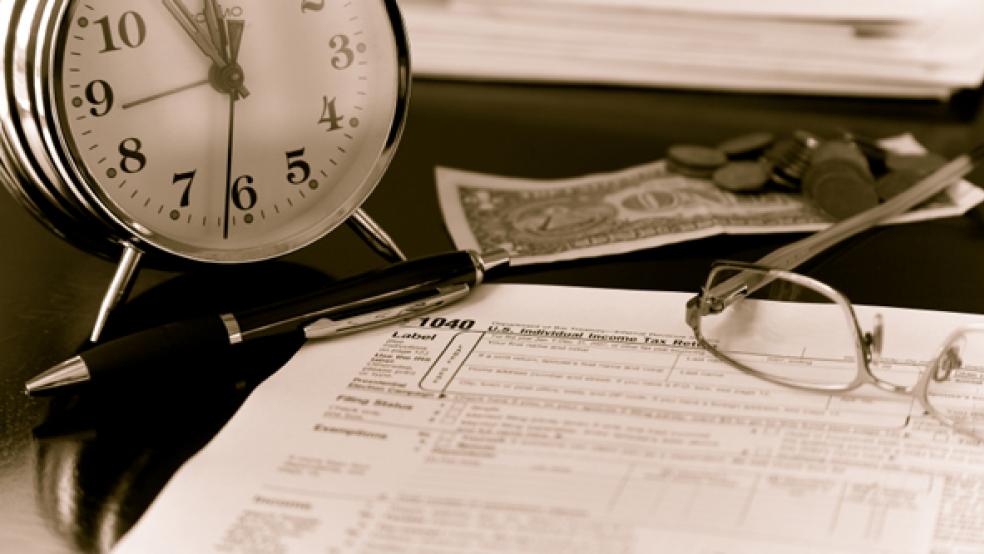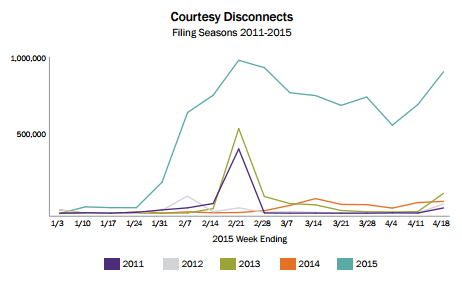When it comes to bad service, the IRS has had a banner year — even by its own lowly standards. The agency hung up on taxpayers calling for help 8.8 million times in the 2015 taxpayer season, according to a report just released by National Taxpayer Advocate Nina E. Olson.
“For the majority of taxpayers who filed their returns and did not require IRS assistance, the filing season was generally successful,” Olson wrote. “For the segment of taxpayers who required help from the IRS, the filing season was by far the worst in memory.”
Related: IRS Says Budget Cuts Could Bilk Billions from Taxpayers
IRS Commissioner John Koskinen had warned that, with the agency’s inflation-adjusted budget 17 percent lower than it was in 2010 and its full-time workforce cut by thousands, service would be “abysmal.” And for anyone who needed information or assistance from the agency, it certainly was.
The nearly 9 million “courtesy disconnects” — IRS jargon for hanging up on callers — was up from 544,000 such brush-offs in 2014, an increase of 1,500 percent. To be fair, the volume of calls the agency got increased by 41 percent, with the duration of each call increasing by 10 percent. Overall, the agency processed 126.1 million individual tax returns, up slightly from 2014, and issued 91.8 million refunds, down from 94.8 million last year.
Some other examples of terrible IRS service from Olson’s report:
- Between Jan. 1 and April 18 of this year, the IRS only answered 37 percent of taxpayer calls that were routed to customer service representatives. Taxpayers who did manage to get through were put on hold for an average of 23 minutes. This contrasted sharply with its call performance in 2014, when the IRS answered 71 percent of its calls, and callers were put on hold for an average of 14 minutes.
- For taxpayers who had been notified that their returns had been blocked by the Taxpayer Protection Program (TPP) on suspicion of identity theft, only 17 percent of calls were answered, with hold times of 28 minutes. For a period of three weeks during tax season, fewer than 10 percent of these calls were answered. Olson noted the need for a single point of contact to help identity theft victims, so they could resolve their accounts and obtain their refunds.
- Libraries and U.S. Postal Service branches did not receive IRS paper forms and publications until Feb. 28, and once supplies ran out, no more were made available. This imposed a bigger burden on taxpayers without Internet access or online literacy. With the adoption of more self-service tools and online services, low income and other taxpayer populations may face greater compliance challenges.
Related: IRS Flunks First Test of Enforcing Obamacare
Olson wrote that many of the service problems could be attributed to decreased funding, and to the additional burdens placed on the agency by the implementation of the Affordable Care Act and the Foreign Account Tax Compliance Act with no supplemental funding. “There is no doubt that the deficiencies in taxpayer service are substantially attributable to a lack of resources,” the report says.
The poor service could present issues beyond just the immediate frustration of millions of taxpayers, Olson wrote: It forces taxpayers to turn to accountants or other tax preparers for answers that they might otherwise have gotten from the IRS for free, and it further reduces trust in the agency. That could lead to more people avoiding voluntarily paying their taxes, forcing the IRS to chase them down.
“For a tax system that relies on voluntary self-assessment by its taxpayers,” Olson wrote, “none of this bodes well.”






